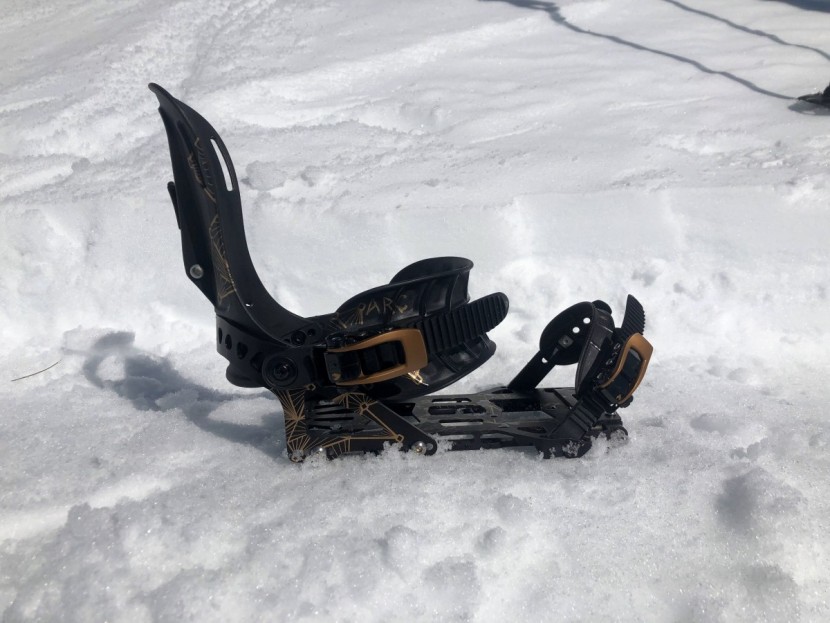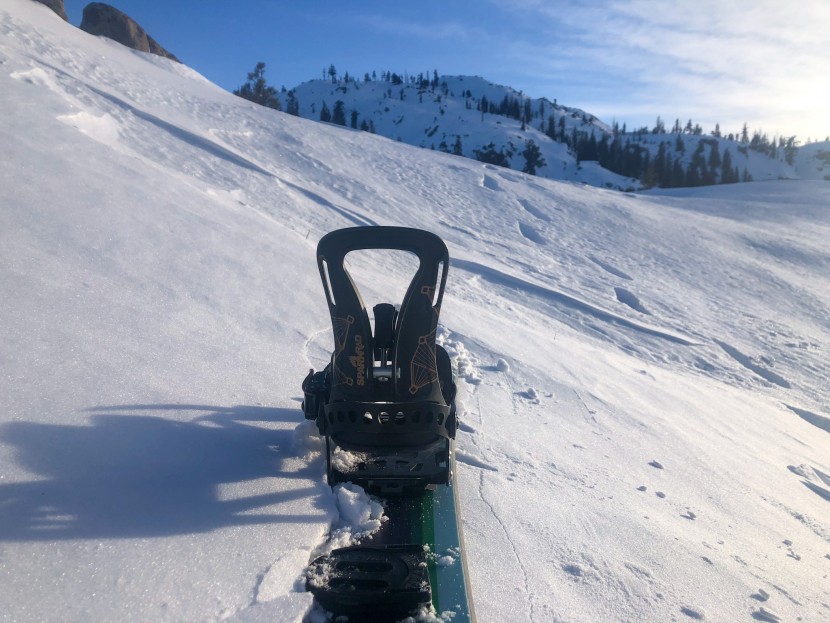Spark R&D Arc Review

Our Verdict
Our Analysis and Test Results
Spark R&D offers their latest ST (Smooth Touring) technology for this binding. This tech is featured in the ST Brackets and ST Whammy Bars of many of their new bindings. These components are manufactured with a thermoplastic overmolding technique that covers some metal parts of the binding, increasing durability and reducing friction. We're linking to the updated Arc ST binding in our review. Compare the model we tested (above, left) with the Arc ST (right).
Spark R&D takes a simplistic design approach to their bindings, and the backcountry is an environment where function trumps all. The fewer the steps, the faster the process. Ultimately, it's easier to use, and there's less that can go wrong. The design team at Spark R&D built a binding to alleviate user issues rather than create them. We found the benefits of this in every metric, especially weight.
Uphill Performance
The Arc tours incredibly well. We looked at the overall uphill efficiency of the bindings and noted their quality of stride, sidehilling ability, and comfort.
The majority of our touring day is spent walking. In its simplest form, that is just sequential strides, so they need to be efficient. The Arc's highback has more negative lean than the category average; this allows for the longest stride, which in turn allows for a higher level of efficiency. Imagine going for a leisurely summer hike, but being forced to shorten your stride by 30%. Though this wouldn't be an issue over a very short distance, you would feel the extra exertion over the course of a day.
If you were suddenly allowed to take your natural (longer stride), you would immediately notice the improvement; this is the promise of the large degree of lean provided by the Arc. The Arc's touring bracket proves a very low friction pivot point with a large range of motion. The -13 degrees of lean, and a very low friction pivot point with a large range of motion provides an incredibly high-quality stride.
If you're touring on firm snow, the binding provides supportive sidehilling. Its lower sidearms, which are near the heel, don't offer as much support as some competitors, which becomes more noticeable in softer boots. We still found it to be plenty supportive for all our sidehilling endeavors. The metal base plate is very responsive and provides levels of comfort that are on par with the industry standard; it's also fit for all-day use.Weight
Weight is a critical component of any ascension gear, especially when it's on your feet. One pound of additional weight on your feet is like adding five additional pounds to your backpack. Fortunately, the Arc is one of the featherweights on the market.
We weighed one binding for reference; because you can't tour with only one binding, we also weighed the complete package. Every screw, bracket, and puck was accounted for. One binding weighed in at 636 grams or one pound 6.43 ounces.
This is impressive since the heel risers are attached to the binding itself. To shave off weight Spark strategically milled out baseplate to remove any excess metal without compromising strength. The tour-ready kit clocks in at 1654 grams or three pounds 12.46 ounces, making the Arc one of the lightest bindings in the category.
Transitions
When Spark R&D developed the Snap Ramp and eliminated the slider pin from their higher-level bindings, it was a significant development for splitboard bindings. Without breaking from the slider puck interface, they simplified the process and sped up transitions. They've improved upon this process in a lighter and simpler way, via an impressive engineering solution.
It's quick and easy to lift the end of the Snap Ramp and slide the binding out of the touring brackets at the top of your objective. It was straightforward and simple to push the bindings back on and press down on the Snap Ramps, which locks the bindings in place. Our testers could do it with no problem, even with gloves on. The passive attachment system is resistant to icing. If any snow is in the way, the action of pushing the binding on the pucks clears any snow in the way. The Spark T1 system might be the fastest transition available, especially in inclement weather. The T1 system is our favorite way to transition because of its efficiency, simplicity, and reliability.
Downhill Performance
The ride of the Arc did not disappoint. We've seen many complaints about splitboard bindings and their stiffness. This model has a responsive baseplate and has a nice medium flexing highback.
This binding provides a responsive and fluid feel. The highback is stiff toe to heel and has good lateral flex. The well-blended high back resulted in a responsive and playful experience. The play allows for tweaked grabs and weight shifts from the tip to the tail of the board to make surf styled turns. The Arc is one of the best split bindings for this style of riding. The downhill performance is catered toward everyday use and for riders looking for a playful feel with plenty of response. Something to note with this binding is that The highback might be soft for heavy riders (200 pounds plus).
Straps, Lean, and Risers
The straps, lean adjusters, and risers are the most commonly touched and used features on a binding. Efficient designs on these features can help you save time and avoid unnecessary frustration. The Arc is thoughtfully featured, making these critical parts effective and user-friendly.
Straps
After we completed our side-by-side testing, we determined that the toe and ankle ratchets and straps were the best of any competitor. Burton produces the ratchets; not only do they grip extraordinarily, but they release quickly and reliably. The Arc features the Pillow Line straps; this one-piece molded strap is surprisingly comfortable, light, waterproof, and should last the test of time. The toe and ankle straps feature easy adjustability to accommodate a reasonable range of boot sizes.
Lean
The forward lean adjuster (FLAD) is another high point, and it's easy to switch the adjuster from skinning (negative forward lean) to riding (positive forward lean). Dialing in the preferred amount of forward lean is achieved by twisting the adjuster. While this allows for precise customization, it does make it a bit tough to ensure that both adjusters are set for the same amount of forward lean (assuming that is what the rider is seeking).
The Rip'N'Flip adjuster is by far the best due to its ease of use. Just like the name says - you rip, flip, and then rip again. When in touring mode, the binding has -13 degrees of lean, which is more than the market average. The benefit here is it increases your stride length on flat terrain. On really long days, especially with low-angle approaches or exits, this is a welcome feature, as it increases your touring efficiency. Arriving with more energy at the top allows for more fun on the descent, while arriving at the top at a faster pace allows for more laps and more summits in your day.
Risers
The climbing bar riser lives on the underside of the binding. A single riser bar with a tab on the buckle side of the binding provides two levels of height for climbing. The height can be changed by moving the riser into either of the two settings via your ski pole. The riser clicks into each setting with an audible noise. Our reviewers found it challenging to deploy with softer baskets. However, everything has a technique, and once you figure it out, it becomes second nature. Overall, it's an improvement from years past with no sidebar.
Value
This model comes in at an incredible price. It's definitely worth the added benjamin to purchase the Arc instead of an entry-level binding.
Conclusion
The Spark R&D Arc is an incredible binding designed with simplicity in mind. Its design reduces weight, yet increases its efficiency, user-friendliness, and overall performance. This affordable binding is designed for any level of rider looking for a balance of response and play that will perform well in all conditions.
| Awards | Best Bang for the Buck |
|---|---|
| Price | $459 List Check Price at Backcountry |
Overall Score  |
|
| Star Rating | |
| Bottom Line | Top-notch performance that keeps your wallet in mind |
| Pros | Uphill and downhill performance, lightweight, good value, efficient transitions, lean adjusters |
| Cons | Heel risers can be challenging to deploy with softer baskets |
| Rating Categories | Spark R&D Arc |
| Downhill Performance (30%) | |
| Transitions (30%) | |
| Uphill Performance (20%) | |
| Weight (10%) | |
| Straps, Lean, Risers (10%) | |
| Specifications | Spark R&D Arc |
| Measured Weight (pair) | 2.8 lbs |
| Compatible Systems | Spark Pucks, Voile Pucks (Regular or Canted), Burton Channel Pucks, One Binding System, and Ibex Crampons |
















